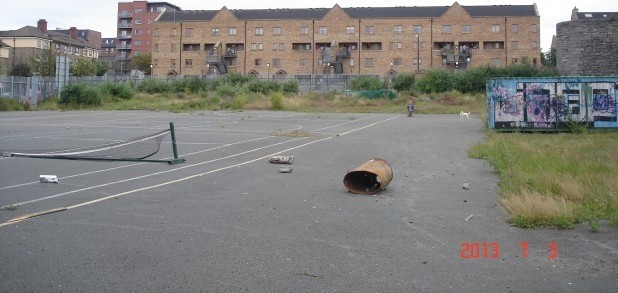
Plans That Never Were & Plans That Are
The Irish Government, MIT (Massachusetts Institute of Technology) and MediaLab Europe were the bodies back in 1999 who came together to initiate the Digital Hub Project. This was to be put in place as part of the Local Area Plan (LAP) for the regeneration of the Liberties area via housing, accommodation, greens and parks, and to overall encourage businesses to move to the oldest part of Dublin City.
The “Taoist” in ex-Taoiseach Bertie Ahern was leading the Celtic Tiger right into the Liberties Jungle in the late nineties with many big plans to improve the existing infrastructure and revive this nostalgic corner of the city. MediaLab Europe rented the premises where The Digital Hub was formed for a nominal fee from the State, who kept its ownership of the premises. The Irish Government decided to invest in MediaLab Europe by way of the Higher Education Authority and also in Irish Universities by funding their institutions with £1 million per year for research. Close to eleven projects were approved, many of them still ongoing. MediaLab went into partnership with the Irish Government and MIT in July 2000, but went into solvent liquidation on the 14th January 2005.
The Irish Government invested in MediaLab in the hope that they would eventually become self-financing by finding corporate funding for the research they were conducting. But unfortunately, the Irish Government could not come to a decision for a funding model to save MediaLab from liquidation. The Digital Hub is managed by the Digital Hub Development Agency, an Irish state agency set up in 2003. The Board of The Digital Hub Development Agency is appointed by the Minister for Communications, Energy and Natural Resources and includes enterprise, education, business, arts, social and urban regeneration interests.
In November of 2005, the SPV (Special Purpose Vehicle) called ‘Digital Hub’ developed by subsidiary company Manor Park Homebuilders Limited, signed a deal of €118 million to develop a 2.66-acre section at the Digital Hub to be referred to as the ‘Crane Street’ site. SPVs are used to isolate financial risk. A corporation can use such a vehicle to finance a large project without putting the entire firm at risk.
Michael O’ Driscoll, a Cork man, DCC and businessman Joe Moran, co-owners of the property development firm Manor Park Homebuilders Limited, developed The Digital Hub, situated on the north and south side of Thomas Street in partnership with Dublin City Council. The rights to develop the rest of the site were awarded to contractors P. Elliot & Co. On the north side of Thomas Street on Rainsford Street, the development for a hotel and several skyscrapers was proposed on the Crane site.
The total development where the hotel was to go up will include a gross-floor area of 39,817sq m of office space. A 360-bedroom hotel with 85x 2-bedroom apartment hotel units and over 5,134sq m of retail space was proposed to be built on the north bound site next to the Guinness Storehouse. It was also proposed that another 125 apartment units (41x 1-bedroom, 52x 2-bedroom, 32x 3-bedroom) and a 2-storey crèche and 2-storey Educational Resource Centre was to be developed.
Eleven blocks in total was to be divided across the site – undoubtedly the most controversial element, Block J (the Hotel Block) was proposed to have a height of 47-storeys over garden podium level! It should be noted here however that the garden podium level itself rises to 4-storeys (therefore Block J may be said to be as high as 51-storeys in height with the inclusion of garden podium floors).
Other striking elements included Office Block K, reaching 29-storeys; Office Block I towering 22-storeys; Residential Block H, which will rise 17-storeys; Residential Block E which rises 15-storeys; Office Block F being 13-storeys and Office Block G being 10-storeys – all above blocks being over garden podium level. Other elements stem to in-and-around 7-storeys in height. The main vehicular entrance to the proposal was planned to be accessed from Rainsford Street. This project quietly disappeared when the Celtic Tiger left the stage. But as the image above illustrates, it would have been something to be seen to be believed.
In April 2010, €12 million was provided by Minister of State for Housing and Local Services, Department of Environment, Heritage and Local Government, Michael Finneran, to develop several regeneration projects at Bridgefoot Street, Queen Street, Lourdes House and Sean Treacy House. Bridgefoot Street runs adjacent to the Windmill site on the west and borders to south on Bonham Street. The Regeneration Bridgefoot Street Project is currently operating as an active community garden and also started doing workshops in August 2015.
The garden is now available for use by the local community as part of the Liberties urban regeneration scheme. Although, this area also had an ambitious plan which has since been placed on hiatus. The proposal was to develop community facilities and 200 apartments that were be arranged around the garden to create streetscapes along the perimeter. Two feature buildings marking the entrance to the garden would greet and lead into a titanium clad community hall, to act as a focal point and a catalyst for local activity and creativity. There was also to be a playground, MUGA (Multi Use Games area), allotments and an area that can be used for markets over weekends introduced at a later stage.

In 2012, the Circle voluntary Housing Company moved DCC tenants from Crampton Buildings to 17 units in Bridgefoot Court. The Bridgefoot Court units had been built by Dublin City Council to great relief of the community and tenants.
About five years ago, in 2010, Bridgefoot Housing Estates joined residents of 20 of the country’s most run down housing estates. In March 2015, they decided to take action against the Irish State after conducting research into the areas housing problems, their case was presented to the European Committee of Social Rights in Strasbourg. In their survey they found that the homes in these estates, including Bridgefoot Street, had sewage problems, persistent leaks, harmful damp and mold, which caused many of the residents, especially the younger children and also the older people, detrimental health problems.
Many felt that the State had spent the €12 million on all these projects in 2010, but the community garden in Bridgefoot, which was only started recently and there is no real evidence of money spent on that specific site that borders Bonham Street and the new student accommodation site. Those monies could have come in handy to solve the problems for the council houses and apartments in the area. And at the same time on Bonham Street itself you have The Mendicity Institution one of the oldest working charities in Dublin, serving food to the homeless.
The council has been engaging since last year in further consultation with elected members, the community and also stakeholders to work towards agreeing a final plan and strategy for the Regeneration Bridgefoot Project, as well as working towards a capitol programme for the project. The council said that they hope to finalise the plans and see them approved within six months, with the public consultation phase being implemented within two to three months, this was in December 2014. Since then as stated prior, the project was shelved.
A new student complex at the Binary Hub on the south side of Thomas Street, to the north of Bonham Street, next to Bridgefoot Street is already being built. It is opening in September 2016. The complex will have 100 apartments, providing 471 student beds. The developer of the site is a UK company called The Student Housing Company. The project managers for this project are Healy, Kelly, Turner and Townsend. The Contractor for Construction is Bennett Limited and the architecture was done by O’Mahony Pike Architects. Structural Engineer, DBFL Consulting Engineers Limited and Mechanical and Electrical Engineer, Axiseng Consulting is responsible for the engineering.
The student accommodation complex at the Windmill site is estimated at €40 million and is being funded by the state. The development will cover 10,560 sq feet of office space and student accommodation – creating more open space. So at least we got one of these developments!











